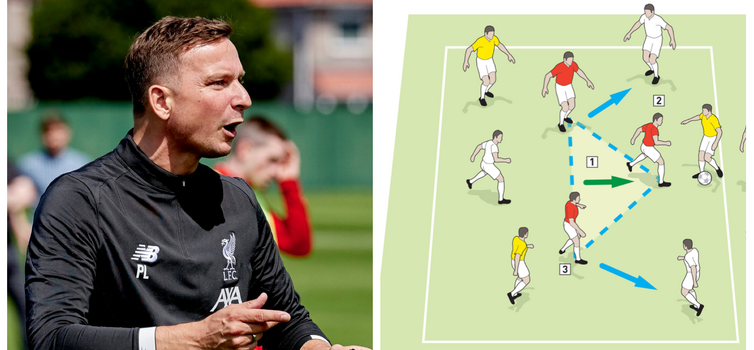Lijnders: How Liverpool build counterpressing into every session

Lijnders says Liverpool's rondos are often pressing exercises
Written by Simon Austin — December 5, 2019
PEPIJN LIJNDERS has revealed how counterpressing - the foundation of Liverpool’s playing philosophy - “comes back in every exercise” in their training sessions.
It’s no secret that the Gegenpress (against the press) has been fundamental to Jürgen Klopp’s style of play for a considerable period of time. The idea is to win the ball back as high up the pitch and as quickly as possible, rather than waiting for a pressing trigger or retreating.
"We want to attack the opponent non-stop - when we have the ball, when we lose it and when the opposition have it,” Klopp has said.
There has been a lot of conjecture about whether Liverpool have actually modified their counterpressing in the last couple of seasons because of the physical demands of the Premier League but, speaking to the Guardian, Lijnders insisted it remains crucial to their gameplan.
“The players first have to understand the importance of counterpressing to our team - that element comes back in every exercise,” Liverpool's number two said.
“They have to feel it - not with the head, but with the heart. When a team lose the ball in training, you will hear me, Jürgen or Pete (Krawietz) screaming: ‘Go! Get it back! Don’t stop!’ It’s so loud they’ll even hear that in Manchester.
“They have to understand why it’s so important. That power and emotion is our game; our identity is intensity. That comes back in every drill. It’s quite simple - it’s just about the continuing stimulation of our mentality to conquer the ball as quick and as high up the pitch as possible.
“Attack the opponent with – but especially without – the ball; a chasing attitude over 95 minutes. Our way of playing is central element in our training sessions."
Lijnders' counterpressing rondos
6 v 3 tactical rondo
Lijnders, who said he's responsible for "training process” at Liverpool, described two rondos used to practice counterpressing at Liverpool.
The first involves a six v three possession game (pictured at the top, on the right), which is “about instant transition and not dwelling on disappointment after losing possession”.
Klopp has also talked about this drill, played inside a 12x12 yard square, in an excellent article with LMA-affiliated Elite Soccer magazine earlier this year.
The three counterpressing players hunt the ball in a triangle and need to show great "hunger" in doing so.
“The closest player goes 100% and puts total effort into the press,” Klopp said. “One player can always defend two opposition by blocking the line, pressing the ball carrier and checking over the shoulder.
“The two last yards of the press define everything. As far as aggression goes – yes please! – but this must be controlled with an anticipation of where the next pass will go, and with team mates reorganising as a group constantly and quickly.”
After 20 minutes of this tactical rondo, Liverpool then go into a 30-minute game scenario, with eight v six.
“A high-intensity and counter-pressing team will often make more mistakes because we attempt more and perhaps accomplish more – ultimately, patience and an expectation of making mistakes is actually okay,” Klopp explained.
'Milly’s rondo'
Whereas rondos are often characterised as possession games, Lijnders said they are usually about pressing at Liverpool.
“The five-v-two rondo is a good example," the Dutchman explained. "It’s actually called Milly’s rondo now, after I got inspired by James Milner, because he always intercepted the ball within the first few passes.
“He was really quick and brought the focus of the rondo to another level. I was like, ‘How can I come up with a rule that everyone will execute with his kind of intensity?’
“So I gave an extra incentive for the two players in the middle if they would intervene within the first six passes. So I told Milly: ‘This is your idea!’ The other players loved it. The five-v-two rondo is in fact is a pressing rondo.
"Our game is about movement and speed, and with only five players those five have to run non-stop.
“The two guys in the middle are encouraged to make an interception within the first six passes. If they succeed, they can go out both at the same time, otherwise only the player who intervened is allowed to leave the middle.
"This all stimulates our counterpressing vision where we try to disrupt the build-up of the opponent inside their first few touches.”
'Every player is an attacker and a defender'
Lijnders said: “Jürgen is the leader and face of the team, the one who defines the character and who stimulates everyone”.
And, unsurprisingly, it's the German who describes the importance of counterpressing to Liverpool better than anyone else.
“We want to attack the opponent non-stop when we have the ball, when we lose it and when the opposition have it,” he told Elite Soccer. “Put another way, defending is our first offensive action.
“Each exercise should have this character, directly defined by our specific way of playing, where everyone is responsible for everything in the form of modern total football.
“In real terms, that means we have a team of 11 at a time, each of whom is an attacking forward and each of whom is a defender.”
It's this characteristic which makes Liverpool unique, he believes. In February, following the 3-0 Premier League win over Bournemouth at Anfield, Klopp said: “That’s what we wanted to show - that we are a team who are able to play really good football. But if we lose the ball we must be different to all teams in the world.”






-1.png)





